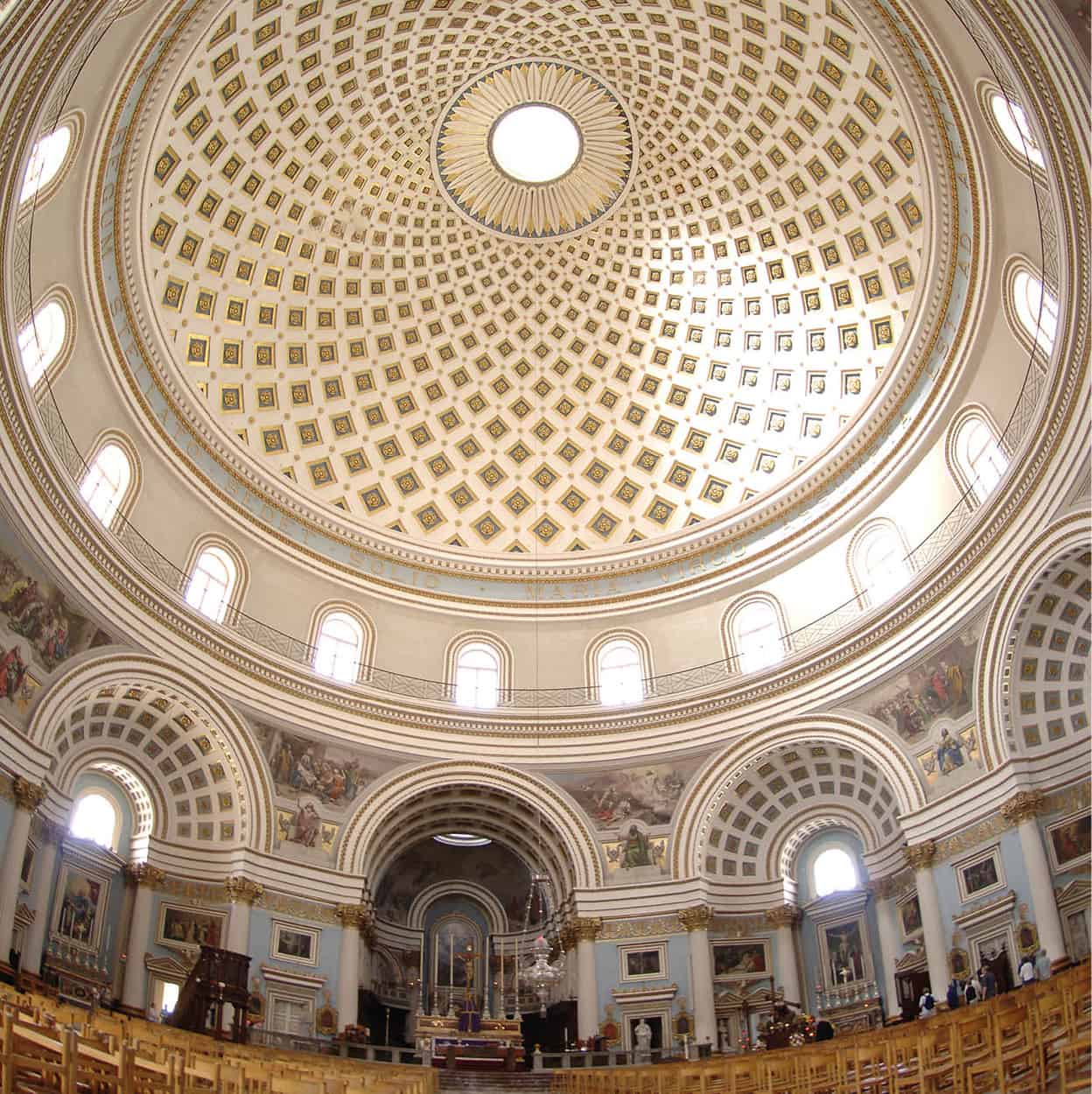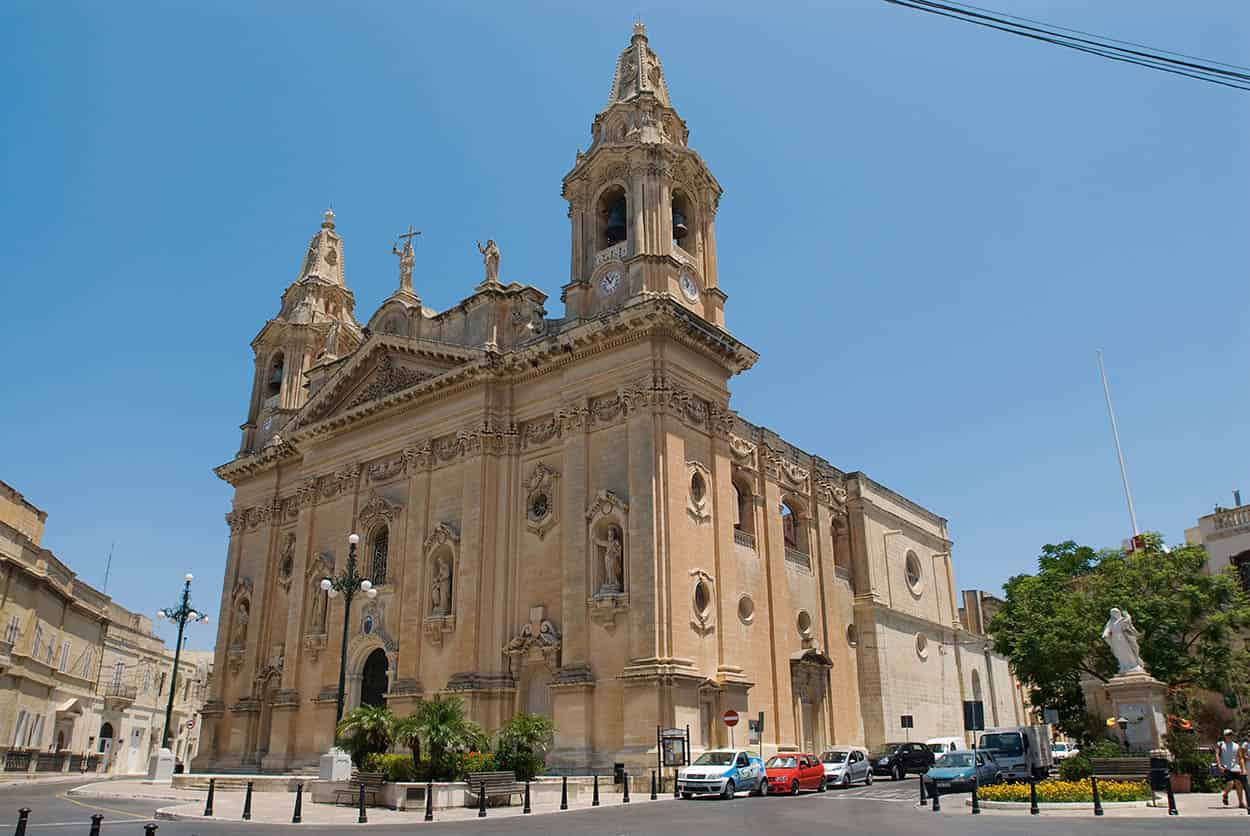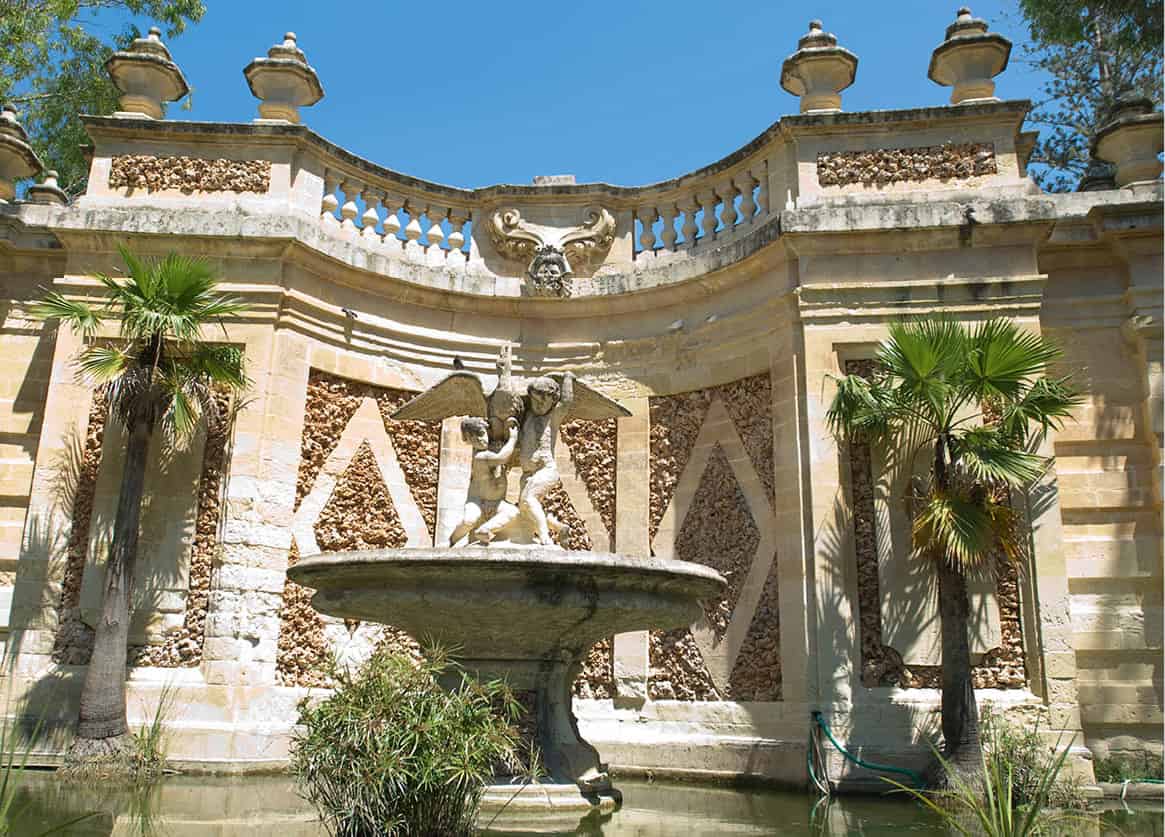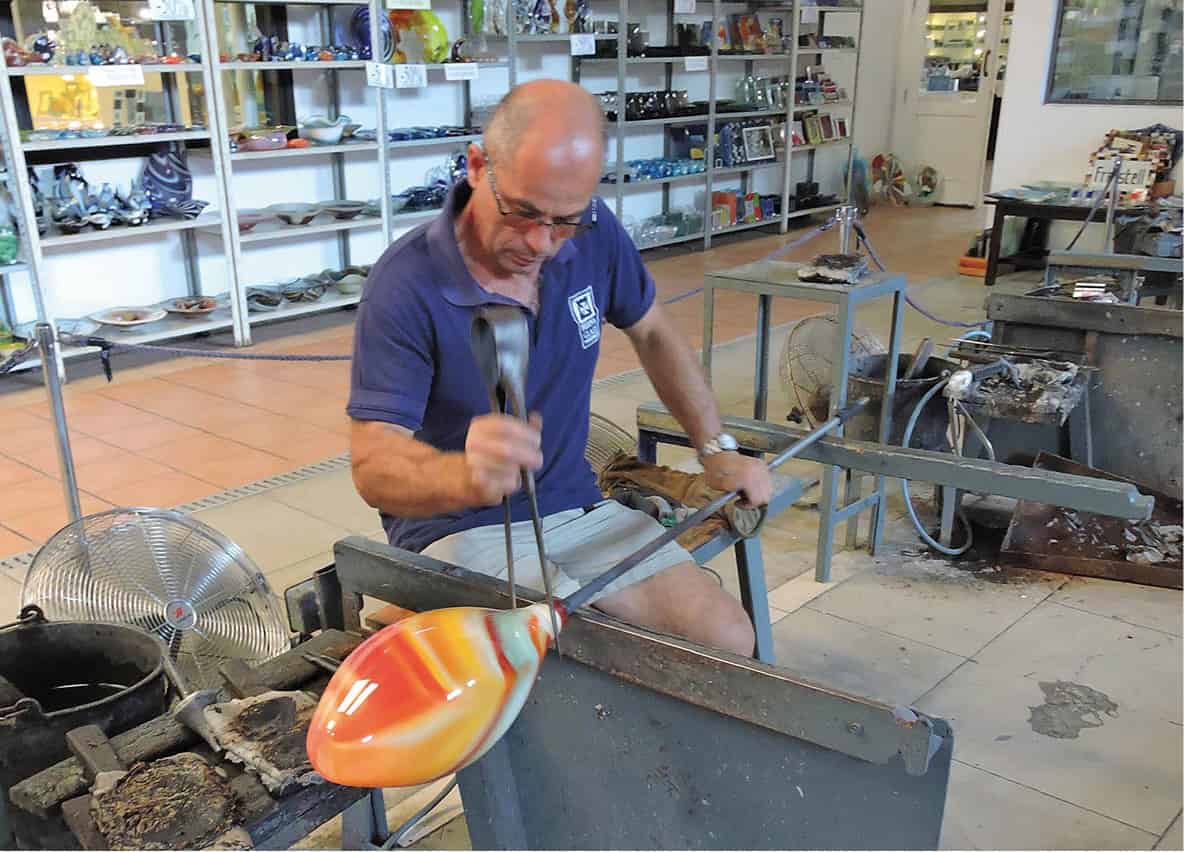The best view of Malta, and particularly of the central part of the island, is from a helicopter. If you imagine it as a dartboard then the bull’s-eye is the great dome of the church of Mosta 1 [map] (http://mostachurch.com). If you cannot get up this high then a good substitute is the bastion walls of Mdina, from where the immensity of this great building can also be appreciated.
The miracle of Mosta
Mosta Dome or, to give it its correct title, the Church of Santa Marija Assunta, can be seen from almost any vantage point in Malta. The islanders take great pride in its impressive scale. At 40 metres (130ft) in diameter, it “out-domes” St Paul’s Cathedral in London by 6.7 metres (22ft), and is reputed to be either the third- or the fourth-largest unsupported dome in the world, surpassed only by St Peter’s in Rome, Hagia Sophia in Istanbul and (though Mosta Dome officials are not much amused by this recent addition) the church at Xewkija in Gozo. Controversy still rages on this issue and unless you are prepared for an argument, it is best not to get too engaged in such local disputes.

The geometrically patterned interior of Mosta Dome.
Viewing Malta
Whatever its size ranking, the Mosta Dome is a remarkable church with an elegant interior, built amid great controversy to the design of Giorgio Grognet de Vasse that creates a round church rather than a church shaped like a Latin cross. The first stone was laid in 1833, and the church took 27 years to complete. Its generous size came about because it was erected around a church already existing on the site. The original one had become too small for the growing parish but could not be demolished until an alternative was available.
During the heavy bombardments of World War II, a bomb pierced the dome while the church was crammed full of parishioners sheltering from the air raid. It skidded across the floor but, miraculously, did not explode. A replica is on display in the church.
Drink
Malta’s centre has become popular for its wine bars, often located in old town houses, and locals flock to them for a true taste of tradition. A favourite is Cellini Wine n’Dine (www.celliniwinedine.com; Mon–Sat 7pm–midnight), just across from the parish church in Naxxar, which serves gorgeous meat and cheese platters, as well as an ample selection of wine.

Our Lady of Victory, Naxxar.
Sylvaine Poitau/Apa Publications
Naxxar
Just north of Mosta, and now virtually connected to it by continuous strip development, lies the town of Naxxar 2 [map] (pronounced “Nash-shar”). Like Mosta, it has a parish church of prodigious size: Our Lady of Victory was completed in 1616 by Tomasso Dingli, a prolific boy-wonder architect who distinguished himself with several notable churches in this part of the island. It is certainly worth a visit, if you can negotiate the traffic screaming all around it.
Opposite is the Palazzo Parisio (tel: 2141 2461; www.palazzoparisio.com; daily 9am–6pm; free access to the gardens). This is named after the same Parisio family whose principal house in Valletta was commandeered by Napoleon. The Naxxar house was rebuilt to its present state in 1898 for banker and philanthropist Giuseppe Scicluna, though he only enjoyed it for a year before his death in 1907.
The Palazzo Parisio is an outstanding example of a Maltese stately home, and the finest of its kind open to the public. It is said that its construction and furnishings set new standards for the island, and certainly its carved Lombardy furniture, stucco friezes, painted ceilings and Carrara marbles are remarkable. The great marble coping stone over the balustrade is the longest single piece on the island. It is said to have been transported by countless mules, and the full story is excellently explained in the audioguide.
Today the palazzo is still in family hands, and is run by the vibrant mother-daughter team of Christiane Ramsay Scicluna, Baroness of Tabria, and her daughter Justine Pergola. They have successfully transformed it into a thriving business – between the museum and the charming Luna Collection (a beautiful café, fine-dining restaurant and lounge bar), there is always a reason to visit. The gardens are also spectacular, and considered some of the best in the country.
Parish Churches
The central region of the island features some of Malta’s largest parish churches. The first of these, built to accommodate the fast-growing populations of expanding parish boundaries, were St George at Qormi and St Philip at Zebbug. They were erected to show village wealth as much as the visible face of the Church. But it is Attard’s parish church, dedicated to Santa Marija, that heralds the splendours to come. It was designed by Tommaso Dingli (1591–1666) in 1613, when he was just 22 years old.
This young man went on to become one of the island’s most prolific architects and is probably best known for his work on the parish church of Santa Marija in Birkirkara, a triumph of indigenous design and sculpture, and a fine example of a Maltese Renaissance church. Later, he went on to design the parish churches of Naxxar, Gharghur, Gudja and Zabbar. Not that they all remain, as Attard’s does, as he envisaged them. As the parishes grew, alterations were made since many proved too small for their congregations. In fact, Dingli’s Birkirkara church was never completed because even then they knew it would be too small. Our Lady of Graces in Zabbar was not only expanded but also given a new dome as the original was damaged by French cannon fire.
The Three Villages
From Naxxar take the road to Balzan, which, along with Lija and Attard, make up the “Three Villages”. Despite the promising olde-worlde title, don’t expect to see villages in the conventional sense. Indeed, you will be hard pressed even to distinguish one community from the other. In recent years the three have grown into one virtually amorphous mass, with their boundary lines known only to the residents.
Fact
For centuries, the Three Villages has been a very desirable address. Property prices are constantly high and there are superb patrician houses dating back to the 17th century.

A peaceful corner of San Anton Palace Gardens in Attard.
Sylvaine Poitau/Apa Publications
Attard
The area is exclusive and the president’s official residence is in Attard, at San Anton Palace. This elegant and stately house was the country residence of the Grand Masters from the early 17th century. Grand Master Antoine de Paule (1623–36) was the first to install himself and indulged in the decadent type of lifestyle that was to become the Knights’ hallmark after the first Great Siege. In the British colonial era it was used as the governor’s residence, and it has been occupied by the Maltese president since 1974. The palace is closed to visitors but the San Anton Palace Gardens 3 [map] are open daily, dawn to dusk (free).
The gardens are a favourite of expats and older visitors, and feature a surprising variety of subtropical plants. There are aviaries and some nice statuary to add interest but, the gardens’ famous camel departed some while ago, along with other residents of its so-called zoo. There is a café inside the gardens, and beside the gate furthest away from the palace you will find the Melita Garden (www.melitagardensmalta.com), a gracious old house and garden that is popular for its bar facilities and its pizzas.
The President’s Kitchen Garden (tel: 2122 6226; daily 9am–7pm; free) has supplied the palace with vegetables since medieval times, but is now a great option for families. Located just behind San Anton Palace, this stunning space has been opened to the public for the first time, and includes spacious grounds to wander through, as well as a lovely café.
In the centre of Attard is the Renaissance jewel of the church of Santa Marija, designed by Tomasso Dingli. The detailed carvings in the stonework repay a close look, and it is interesting to note that since the temple-like facade could not support a tower, in 1718 a bell tower was placed above the northern transept.
There is little else of sightseeing interest in the Three Villages, though if you are in the area on 6 August, Lija is renowned for the celebrations and superb fireworks at its festa.
Birkirkara
From San Anton Gardens it is a five-minute detour to the densely populated town of Birkirkara 4 [map] (road signs abbreviate this to B’kara). It’s worth the trip to see the church of St Helena, an outstanding example of the Maltese Baroque style. The church was designed by Domenicho Cachia (1710–90) and replaced Tomasso Dingli’s earlier church. The Knights so liked Cachia’s powerfully proportioned design and his rich interior of frescoes, paintings and carvings that they awarded him the commission for Valletta’s prestigious Auberge de Castille – a task that he fulfilled magnificently.
Two winding steps lead up to the platform on which the church stands. Aside from the twin-towered facade, the aisle screens and the entablature are striking features of a building that has been described as the finest parish church on the island.
Ta’ Qali Crafts Village
Just outside Attard there are signs to Ta’ Qali Crafts Village 5 [map] (Mon–Fri 8am–4pm). Built on the old World War II airfield, it is not the most attractive of places, with many of the corrugated Nissen huts and workrooms clearly still dating from this era. But if you want to see people making a wide variety of Maltese crafts then this is probably still the best place to come. Visit early or late to avoid the coach tours.
Pottery, lacemaking, weaving, silver working and glass-blowing are just some of the indigenous skills on show. Mdina glass (www.mdinaglass.com.mt) is the best known and largest business of its kind, and it is fascinating to watch the glass-blowing and -forming processes. It is a tourist haven, but prices are generally lower than in city shops.

A glass-blower at work and the finished product at Ta’ Qali Crafts Village.
Viewing Malta
Nearby, the Malta Fair and Conventions Centre (www.mfcc.com.mt) has been a popular addition and has built its name as a venue for concerts, shows and trade fairs. Meanwhile, the Ta Qali Family Adventure Park (tel: 2292 8000; daily 6.30am–11.30pm; free), with its climbing frames and rope structures, is also within easy walking distance.